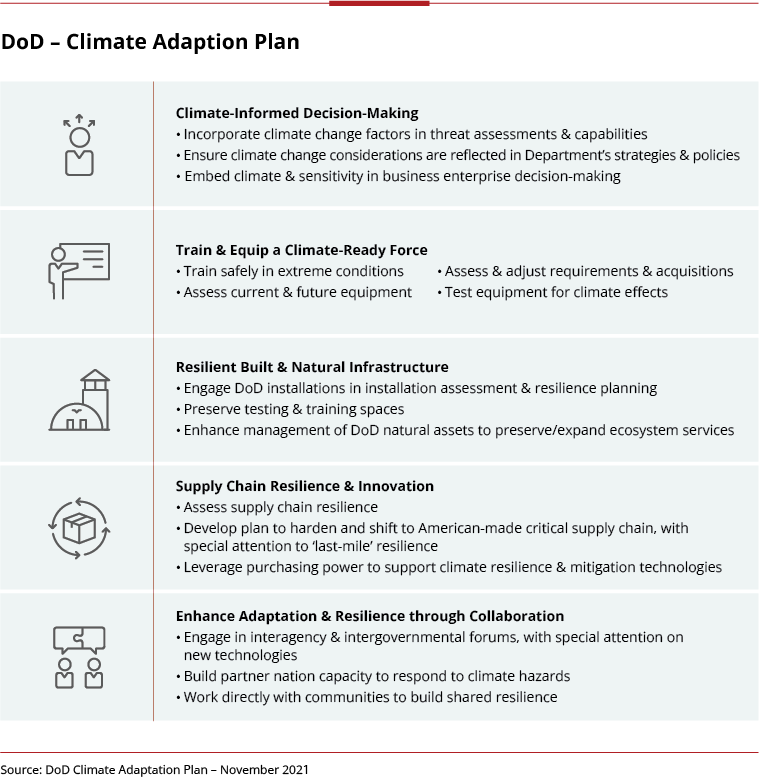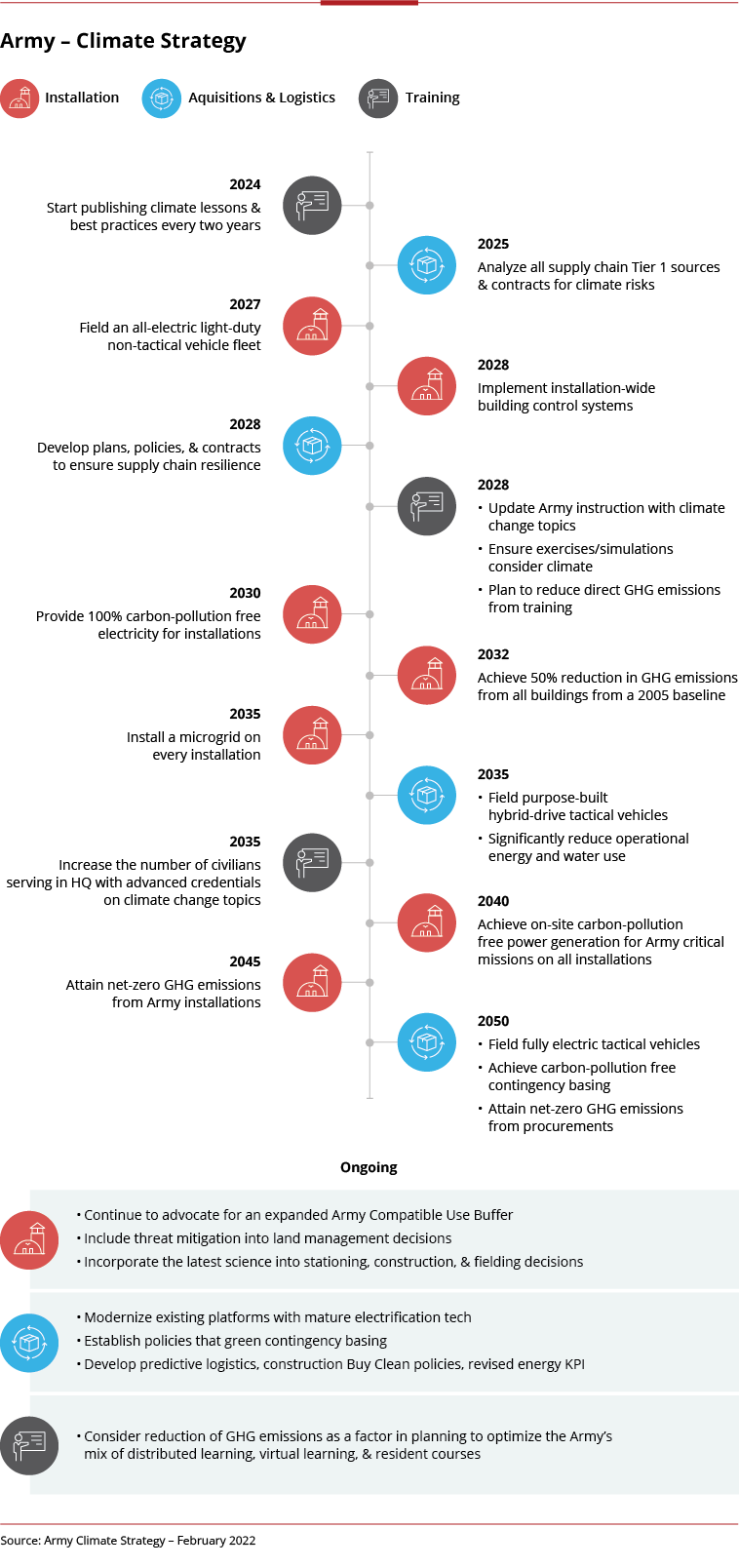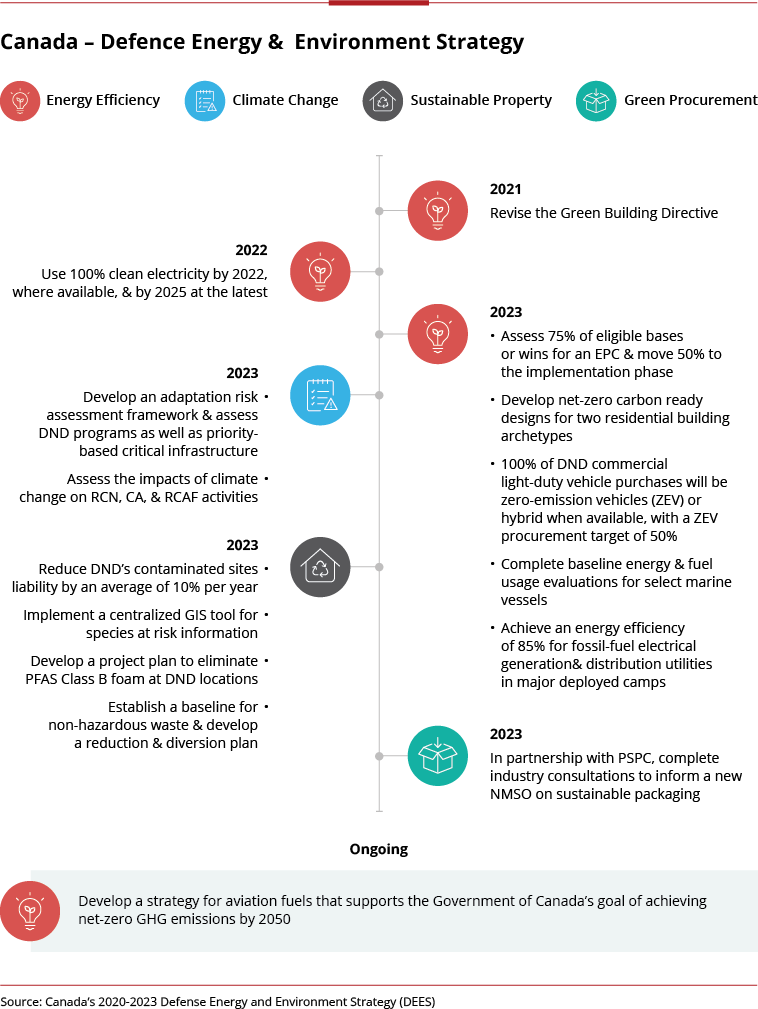Industry Can Help Defense Client’s Climate Change Adaptation Strategies
The US Department of Defense (DoD) and the Canadian Department of National Defence (DND) have identified climate change as a critical national security concern and threat multiplier and are prioritizing their climate change adaptation strategies.
Among other effects, climate change can affect troop health and readiness, degrade equipment, and disrupt supply chain resiliency.
Weather-related events have already cost these customers billions of dollars, with costs only expecting to rise. Climate change also offers unique opportunities to drive innovation and strengthen alliances.
In recent years, DoD and DND have prioritized climate change adaptation strategies (e.g., weatherizing buildings). These customers are also increasingly interested in climate technology solutions as well (e.g., electric platforms and systems).
However, it has been challenging for industry to engage with defense customers on climate topics.
Despite being interested in climate technology solutions, these customers often do not have a clear roadmap of how programs will be defined, acquired, or funded.
The level of support for climate-related initiatives can also be volatile, depending on the political party in office.
Despite these challenges to engagement, industry can and must play an active role in helping defense customers reach their climate goals by:
- Offering solutions that address near-term adaptation goals
- Shaping next generation climate technologies
- Advancing own internal sustainability strategy
Survey of Defense Customers on Climate & Climate Change Adaptation Strategies
US DoD
The US DoD accounts for the majority of annual federal GHG emissions and is taking significant action to reduce its emissions footprint.
With the release of its Climate Adaptation Plan in November 2021, the US DoD has indicated its initial approach to addressing the Biden Administration’s climate goals.
The plan’s five lines of effort lay out procedures to develop a climate-ready force, equipped with the appropriate resources and knowledge to address a range of extreme scenarios (see below).
The DoD has also been turning to industry to better understand industry’s capabilities around climate change adaptation strategies.
In July 2021, the DoD released an RFI to get a better sense of industry’s sustainability initiatives, including climate-related disclosures.
In February 2022, the DoD and GSA launched an RFI to gather information about the possibility for industry to supply 24/7 carbon pollution-free electricity.

US Army’s Climate Change Adaptation Strategies
The US Army currently has the most developed climate change adaptation strategies of DoD armed forces.
Released in February 2022, the Army’s climate change adaptation strategies identify three lines of effort:
- Installations,
- Acquisition and Logistics, and
- Training (see below).
One of the notable proposed goals is an increasingly electrified vehicle fleet (including developing electric tactical vehicles by 2050).
Much of the Army’s response is focused on climate adaptation, but its leadership suggests an increased focus on mitigation as well. These tend to be in areas where changes would concurrently support the Army’s fighting effectiveness (e.g., EVs would increase fuel efficiency and protect soldiers in desert environments).
One key obstacle for the Army will be identifying contracting vehicles and funding for these changes. For example, Paul Farnan, the Army’s acting assistant secretary for installations, energy and environment, noted in February 2022 that the Army is “looking outside of appropriated funds, too, looking for partnerships [to] get these improvements without having to do upfront investments.” [1]

US Air Force’s Climate Change Adaptation Strategies
The US Air Force has yet to publicly release comprehensive climate change adaptation strategies, but has discussed many initiatives.
One of its prioritized initiatives has been focusing on reduction of fuels and exploring alternative fuel options given that the USAF is the largest user of petroleum jet fuel amongst service branches.
The USAF is also focused on the impact of climate change on installations and mission readiness. For example, at a 2021 congressional hearing, a top official discussed changes to installation plans to address base vulnerabilities – as guided by the Severe Weather and Climate Hazard Screening and Risk Assessment Playbook.
The USAF is also showing interest in incremental technology upgrades that would increase operational efficiency alongside positive climate change impacts.
The service is pursuing efforts in:
- Aircraft drag and weight reduction,
- Agile technology and software, and weapon systems sustainment on legacy aircraft, as well as
- Long-term initiatives in advanced airframe design, propulsion and alternative fuels.
More effective software/automation capabilities have also been highlighted as a means of saving planning time and enabling fuel savings.
US Navy’s Climate Change Adaptation Strategies
Like the USAF, the US Navy has also not yet publicly released climate change adaptation strategies, although has been active in issuing reports highlighting urgency of climate change.
Existing Naval climate activity largely addresses the impacts of
- Sea-level rise,
- Land subsidence, and
- Coastal change on installations.
Concerns over the growing number of coastal flooding events are generating the impetus to conduct resilience projects, raise docks, and modernize shipyards.
Despite these concerns, USN has been slow to carry out key climate projects (e.g., Key West, Pearl Harbor installations have yet to complete resilience plans) and has dismantled its Task Force on Climate Change.
In 2018, the US Navy also canceled its Green Fleet plan developed under the Obama Administration to install hybrid electric drivers.
However, USN has seen some success – the organization set a goal in 2009 to obtain 50% of all energy consumed from alternative sources (65% of energy consumed at installations was provided by alternative sources, as of 2018).
Additionally, the organization continues to prioritize climate and meteorological monitoring efforts.
For example, the Naval Meteorology and Oceanography Command currently monitors Arctic sea ice to understand how climate change is shaping the operational environment in the Arctic.
Canada DND’s Climate Change Adaptation Strategies
The Canadian DND and armed forces drive ~60% of annual federal GHG emissions.[2] While the DND has to date been exempt from mandatory federal GHG emission reduction targets, they are still actively looking to do their part in greening government.
Climate considerations have been spotlighted in many of the policies released by DND in this past decade (e.g., “Strong, Secure, Engaged: Canada’s Defence Policy”).
In 2020, the DND released the 2020-2023 Defence Energy and Environment Strategy which outlined four key goals (see below).
The government also indicated commitment to consider Indigenous businesses in all areas of green procurement whenever possible (at minimum 5% of spending).

How can industry help with Climate Change Adaptation Strategies?
1. Offering solutions that address near-term adaptation goals
In the near-term, defense customers need support from industry to make progress on climate change adaptation strategies and targets.
Existing and new providers that provide services or solutions focused on logistics resiliency, installation weatherization, climate training, risk assessment, etc. will be best-positioned to help customers reach these goals.
2. Shaping next generation climate technologies
There is clear appetite for new climate technology solutions and innovation, although defense customers are risk-averse and will only opt for mature, proven technologies.
For example, the Army is willing to invest in all-electric non-tactical (logistics) vehicle fleet by 2027, but will not commit to field fully electrical tactical vehicles until 2050.
Industry should be proactive in working with customers to demonstrate the realm of possible to shape future green procurement.
Firms may need to find alternative contracting options to demonstrate a proof of concept before customer is willing to invest to scale.
Traditional commercial (or dual-use) providers that are agile and have expertise in bringing new concepts to market may be best positioned for success.
3. Advancing internal sustainability strategy
Although green criteria have yet to be explicitly incorporated into bids, defense customers are likely to increasingly show preference for solutions and providers that whenever possible offer the more sustainable option, above and beyond legal compliance requirements.
Firms should make sure they have a robust internal sustainability strategy in place to ensure they are meeting environmental requirements in future bids and programs.
